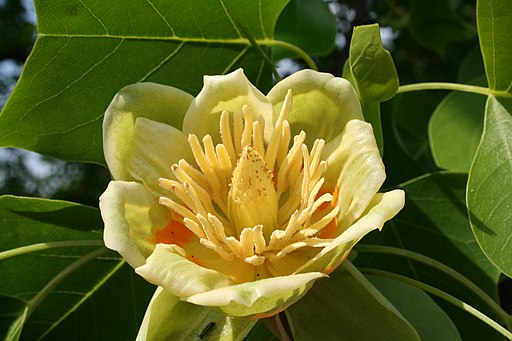Tiptoe through the window
By the window, that is where I’ll be
Come tiptoe through the tulips with me ~ Lyrics by Al Dubin
You might not believe it, but spring is almost here. I know we got walloped by another heck of a lot of snow yesterday, but only the day before the ground finally peaked through old snow drifts in spots to reveal dirt. People shed winter coats, sported t-shirts, and desperately sought out patios to sun themselves on. That is exactly what all those patiently waiting bulbs are gearing up for too; an end to snow and sunshine to flourish in.
And while crocuses and snowdrops might be first to bloom in your garden, there are other blossoms (like tulips) that aren’t far behind.
Tiptoe Under the Tulip Trees

Tulip Tree – By Jean-Pol GRANDMONT (Own work) [GFDL (https://www.gnu.org/copyleft/fdl.html) or CC-BY-3.0 (https://creativecommons.org/licenses/by/3.0)], via Wikimedia Commons

Image By Jean-Pol GRANDMONT (Own work) [GFDL (https://www.gnu.org/copyleft/fdl.html) or CC-BY-3.0 (https://creativecommons.org/licenses/by/3.0)], via Wikimedia Commons

Image mscaprikell (https://www.flickr.com/photos/mscaprikell/8167427/) [CC-BY-SA-2.0 (https://creativecommons.org/licenses/by-sa/2.0)], via Wikimedia Commons
Other features of note you might want to take into consideration before planting your own tulip tree are its fruit. It has green or yellow 5-7 cm long conical clusters at the tips of its branches. The individual samara (fruit surrounded by a papery tissue that helps fruit fly away) are 4.5-8 cm long. Once they fly off the receptacle remains on the tree, serving as another recognition point for the tulip tree in winter. Just as the preceding flowers are a big draw for bees, the later seeds are an excellent food source for deer, squirrels, birds and rabbits.
So if you would like to tiptoe by this tulip, the season is now to do it. They prefer to be planted in the spring and will provide you with plenty of shade before you know it. Keep it away from your driveway, unless you want its honeydew dripping on your car when it is flowering. Prune it to a strong central leader and then let it grow to its heart’s content. You won’t regret planting this sturdy native tree. If you want to know more, contact CLC Tree Services for details. We will happily answer any questions you may have, or even help you plant a tulip tree of your own this spring!
In the meantime, here’s an interesting video with a few more tidbits about tulip trees. Enjoy!
)

74 degrees yesterday, and 38 degrees today.
Winter needs to back away, spring is most definitely going to take over soon.
I hope the leaves on my Japanese maple don’t come out while the freezing weather is still lurking about.
Same story here; from -16C (3F) this morning to 7C (44F) by Wednesday (got 25cm of snow last Wednesday and are expected to get 5-10mm of rain this Wednesday). Surely Spring will arrive eventually! Good luck with your Japanese Maple!